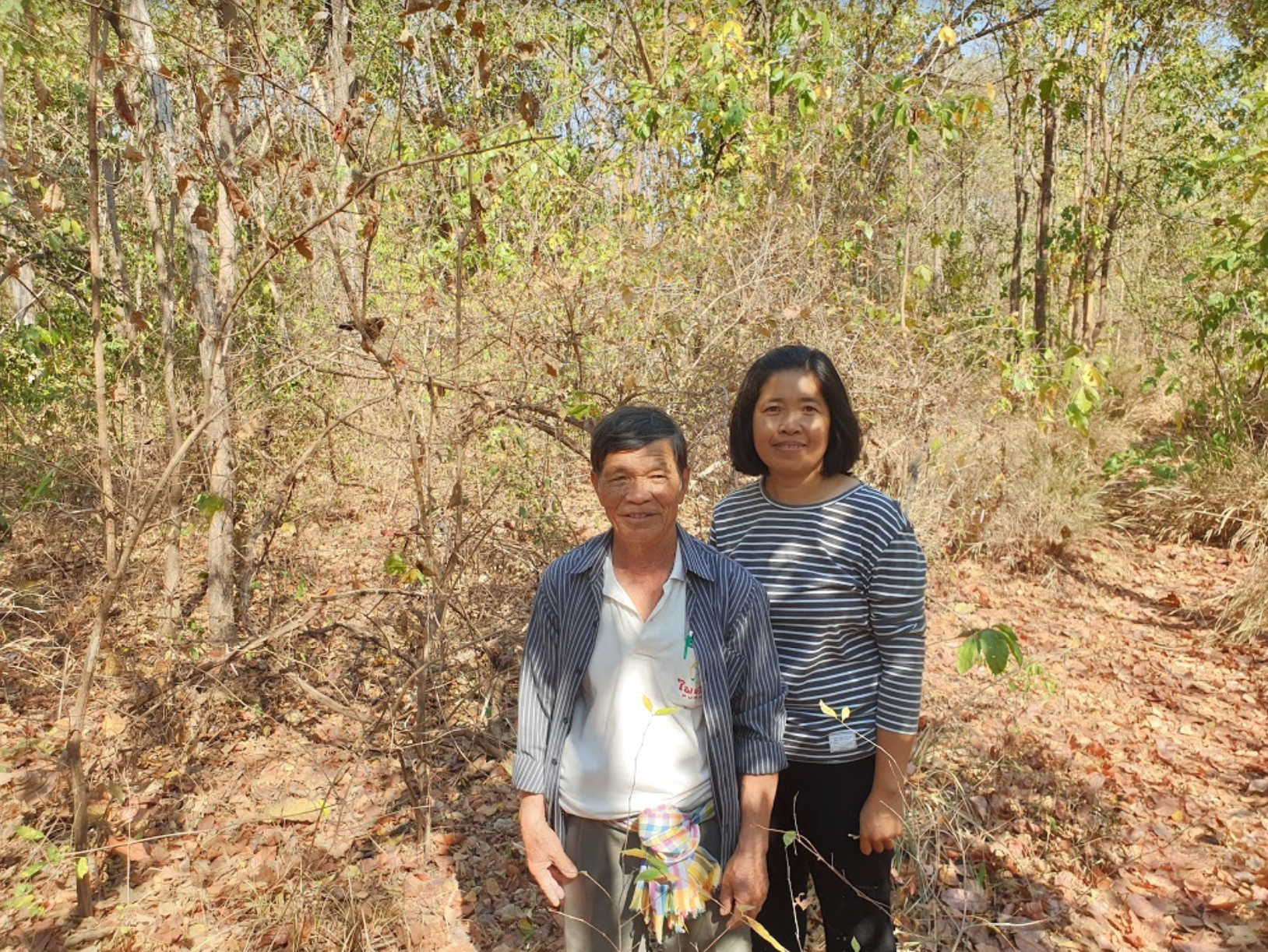In an apparently endless monocrop dessert in Thailand there is a visionary group of communities that woke up to the destruction of their forests and took action to save them from loggers. Decades later these cherished forests provide abundant seasonal harvests of wild products to the villagers and are the home to great diversity (including king cobras). Protecting and managing these forests was made possible by great leadership and constant community support. In this article we explore the story of these forests and the lessons shared by one of the community leaders, Uncle Nawm.
The fall and rise of a community forest
Deep in the countryside of Thailand, the community of Khao Din and their neighbours stand out as 100,000 acres of community forests contrast with the endless sea of monocrops surrounding them. These communities were established by a wave of migrants that settled in the 1960s in a land full of lush and bountiful forests. Initially life was very abundant, with trees becoming timber and plenty of forest products to harvest, eat and trade. As the years went by, most of the forest was cut down and substituted with industrial monocrops. The community eventually became dependent on fluctuating markets of rice and cane sugar. By the 1980s the once abundant communities were struggling with scarcity and rising social issues as they became one of the poorest districts in Thailand.
During the 1980’s a community leader, affectionately known as Uncle Nawm became aware of a plan to privatize one of the last forests in his community. The land grab was organized by a questionable alliance between a local well-off family, a city businessman and local government officials. Uncle Nawm with the support of the local community denounced the fraud taking place and together reclaimed the public forest even facing gunpoint threats! Eventually the villagers won and the forest was officially declared a community property.
In 1986 the NGO Save the Children came in support of the community and made them aware of how their lifestyle had been directly determined by the health of the forest. Protecting their community forest and slowly establishing small agroforestry systems in their land, the community shifted again to produce food and building materials for their own use as a priority and then selling surplus products in the local market.
Three decades later, some villagers continue to practice the legacy of the agroforestry training in the form of diversified integrated farming. I visited a couple of sisters who own a successful mushroom farm amongst fruit trees, Uncle Nawm’s tropical fruit orchard by a fish pond and a diversified family farm with mango trees, rice, ducks, fish, shrimp and rats (yes, farmed rats). Although agroforestry seems to be the main activity for only a few, everyone in the village benefits from the protection and management of the community forest.
Managing the commons
The community forest provides a supplementary income to the local community members and even to neighboring communities. There are defined harvest seasons for bamboo shoots, wild mushrooms and the tender leaves of “sweet vegetable tree”. During the harvest season, local community members can freely harvest these products, while members of neighboring communities have to pay a daily entrance fee to the forest. The harvest is sold to middlemen that wait at the forest entrance and pay a small fee per kilogram directly to the community representatives in addition to what they pay to the harvesters. Volunteers keep strict records of the people entering the forest to harvest, the amounts harvested, the payments in entrance fees and the middlemen’s commissions. During the harvest season the community can generate around USD $10,000 that is used mainly to pay uniforms, food and transport for the local voluntary patrols that ensure that no one is illegally harvesting. Patrols are composed by groups of 5 local villagers that volunteer for one day a month.
All the rules and regulations to manage the forest are democratically established in a monthly village assembly. I had the privilege of joining Uncle Nawm for the monthly meeting were agroforestry, a children’s party, a university research on traditional practices, a women’s empowerment project and a pension fund were all discussed with almost 100 villagers in attendance.
In the last two years climate change brought unseen droughts and high winds that damaged the precious “sweet vegetable trees” and other wild harvest crops. As a result, the community decided to suspend harvesting seasons and give the forest a chance to recover. I asked Uncle Nawm if they had tried to plant trees for human consumption in the community forest and therefore increase the diversity and productivity. They did planted other trees in the past but interestingly, those trees did not survive, only the ones that naturally propagate grew strong.
The example propagated
Neighboring communities from other six sub-districts were inspired by the establishment of the first community forest in Khao Din and went ahead to establish their own. As a result, nine different community forests now cover 100,000+ acres and give thousands of people access to harvest seasonal products.
The management of community commons expanded to establish a series of common water reservoirs. During the rainy season the level of a network of reservoirs rises and temporary canals connect them as a network. With that in mind they chose one lake that does not completely dry during the summer and banned fishing from it. The purpose is to keep a “seed bank” of fish that can swim back to smaller reservoirs during the rainy season when the seasonal canals connect. At first, some community members that opposed the measure and people from neighboring villages kept trying to fish there. An organized response from the community combined with fines eventually deterred the renegades and changed the local culture. Nowadays, if a village assembly makes a decision that affects others communities, like a harvest ban, the message is communicated to the leaders of surrounding villages. The local leaders then use megaphones in the village center to spread the message and let it propagate by word of mouth.
Persisting challenges
Many of the villagers still depend on rice fields as their primary source of income. Unsurprisingly many remain poor. With the help of Japanese cooperation and the leadership of Uncle Nawm, they created a farmers’ association that operates a rice mill microfactory where farmers can store their rice at a very affordable price. The project included five different rice mills, each one operated by different communities. Today only one remains in operation. The main reason according to Uncle Nawm is that the teams set up to manage them were unprepared for the collective governance dynamics and ultimately became too inefficient to remain competitive. The only one microfactory that remains open went through a crisis after three democratically elected managers stole money and brought it to near bankruptcy. Uncle Nawm, had to bring the bad news to the community and saw no other option but to close the operations. Nonetheless, the community insisted to keep it open, appointed Uncle Nawm’s daughter as the new general manager and restructured the operation. Today the rice mill stores and processes small farmers’ rice in almost charitable terms, charging barely enough to break even.
Despite the rice mill supporting small farmers, decades of agroecology workshops, nine community forests and the impressive management of the commons by the villages, people are still struggling to make a living from the land. The younger generations are migrating to the city in search for better paying jobs. Small farmers struggle to get a good price for their products. It seemed that for most of the villagers, the forests were only capable of supplementing their economy and not sustaining it.
Lessons from Uncle Nawm
I learned about the power of good leadership by hearing Uncle Nawm’s stories and witnessing the great reputation and respect he got from other villagers. I saw how a small group of committed people was able raise awareness on the importance of protecting community forests and act on it. They stood up against threats and challenges that seemed impossible by keeping their conviction and unity. The community history also shows how other small group of people, with selfish and immoral intentions, brought several community projects to the ground.
During a feast offered by Uncle Nawm’s family I asked for advice for Nangu. With no hesitation he said that every project based on agriculture and forests needs a good market. If there is no place to sell the products the initiative will fail. This reminded me of Nangu’s strong focus to reach eco ethical markets.
The second advice was the need of a committed leader with the capability to convince instead of forcing decisions on others. He continued: to convince people every leader must understand that there are three kinds of people.
1. The energetic and proactive that act fast. You want to involve them first.
2. The skeptical who either wait and see what happens or straight up oppose you.
3. Those who go with the flow. Neutral people. They could be good or bad for your cause.
He continued: to convince people it is necessary to make them understand what is in for them. They must understand the benefits from the initiative, otherwise they will lose interest and withdraw their support.
His advice was both simple and sobering. His life’s work shows how blending passion and dedication can yield results that benefits entire communities for several generations. Thank you Uncle Nawm for your open heart and example to the world!

